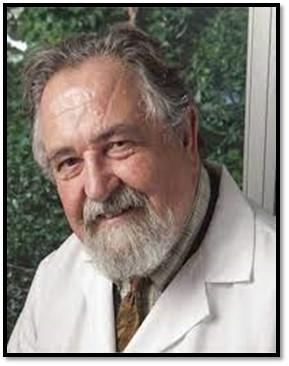Larson recognized for for outstanding achievement in basic nuclear medicine science
Reston, VA (Embargoed until 11 a.m. EDT, June 14, 2021) – Steven M. Larson, MD, has been named the 2021 recipient of the prestigious Paul C. Aebersold Award. Larson is the Hedvig Hricak Chair in Radiology and attending physician of the Molecular Imaging and Therapy Service in the Department of Radiology, member and lab head of the Molecular Pharmacology Program, director of the Radioimmunotherapy and Theranostics in the Ludwig Center for Cancer Immunotherapy, Sloan Kettering Institute, and co-leader of the Imaging and Radiation Sciences Program, Comprehensive Cancer Center Grant at Memorial Sloan Kettering Cancer Center (MSK). He is also professor of radiology at Cornell University Medical College in New York. The award was announced by the Society of Nuclear Medicine and Molecular Imaging (SNMMI) during its 2021 Annual Meeting.
Larson–one of the world’s foremost experts in radiopharmaceutical therapy and molecular imaging–has long-term interest in radiopharmaceuticals for oncologic applications in nuclear medicine and is inventor and coinventor on more than 40 patents for radioactive drugs. He developed one of the earliest 99mTc kit formulations, for 99mTc S colloid–a product that is still in active use today, more than 50 years after discovery. He has worked in various aspects of PET since 1979, including a major role in the development of two large PET programs–at Clinical Center, National Institutes of Health (NIH), from 1983 to 1988 and as chief of nuclear medicine, the MSKCC PET program, from 1988 and 2013. He has served on numerous government advisory committees and chaired the Radioactive Drug Advisory Committee of the U.S. Food and Drug Administration, where he was part of a team that developed the 21CFR361.1 Radioactive Drug Research Committee regulations. He has been principal investigator on several large grants–past and present–from the U.S. Department of Energy (DOE) and the NIH, including the grant that provided funding for Memorial Sloan Kettering’s Center for Multidisciplinary In Vivo Molecular Imaging in Cancer.
Currently, the primary foci of Larson’s lab are molecular imaging, targeted radiodiagnosis, and therapy using small molecules and monoclonal antibodies, especially pretargeted radioimmunotherapy (PRIT). An expert on theranostic applications for targeted radiopharmaceuticals, Larson is currently corresponding primary investigator on a grant entitled 124I-NaI PET: Building block for precision medicine in metastatic thyroid cancer, sponsored by the National Cancer Institute; this research seeks to develop image-based dosimetry to improve selection and management of patients with advanced cancers, using 131I therapy of thyroid cancer as a model paradigm for optimizing radiotargeted therapy treatment planning. Larson has authored or coauthored more than 700 articles in major peer-reviewed journals.
Satoshi Minoshima, MD, PhD, FSNMMI, chair of the SNMMI Committee on Awards, congratulated Larson on this achievement: “Steve is a giant. He is truly a pioneer in nuclear medicine. His contributions to cancer imaging and radionuclide therapy have been enormous. I am so fortunate to have crossed paths with him in this exciting field of nuclear medicine and molecular imaging.”
Upon hearing of this recognition, Larson remarked. “I am truly honored to have been awarded the Aebersold Award by my peers in nuclear medicine. Today I find myself deeply grateful to my mentors–especially Will B. Nelp, MD, director of nuclear medicine at the University of Washington Medical School in Seattle, and Henry N. Wagner Jr., MD, director of nuclear medicine at Johns Hopkins University Health Sciences–who afforded me unparalleled instruction in basic and clinical aspects of nuclear medicine. It has also been my great privilege to have trained more than 150 MD and PhD clinical and post-doctoral fellows in nuclear medicine, and I hope that I have returned the favor of wise instruction by passing along what I was taught. Along with my trainees, each day I sought to remain a student, and together we learned much from clinical and laboratory experiments. With the help of outstanding collaborators at the University of Washington, NIH and of course Memorial Sloan Kettering, I am proud to say that all of us working as a team were able to feel the joint satisfaction of adding to the scientific knowledge that has advanced our field. As I near the end of my career, I predict a great future for nuclear medicine as it takes fresh advantage of the revolutionary increases in the fundamental understanding of human biology–in cancer biology, function of the brain, developmental biology and immunology, as shining examples. These advances of basic biology must inevitably incite future inventions that will lead to improved diagnosis and therapy with radioisotopes–for the benefit of sick patients, rich and poor, throughout the world.”
Larson received his medical degree from the University of Washington School of Medicine in Seattle, Wash., and served his residency at Virginia Mason Hospital in Seattle. He has received numerous awards for excellence in nuclear medicine, including the Georg Charles de Hevesy Nuclear Medicine Pioneer Award, the Wagner Lectureship, and the Berson-Yalow award from SNMMI; the G.V. Hevesy Lecture-Medal of the European Society of Nuclear Medicine; the Pendergrass Award and the Radiologic Researcher of the Year Award from the Radiological Society of North America; the Louise and Lionel Berman Foundation Inc. award for accomplishments in the field of nuclear medicine involving the peaceful use of atomic energy; the 2021 Saul Hertz, MD, Award of SNMMI for therapeutic nuclear medicine; the Ralph G. Robinson Lecture Award of the American College of Nuclear Physicians and the Gold Medal of the American College of Nuclear Medicine, among others. He was awarded the Wylie medal of the U.S. Food and Drug Administration (FDA) for his contributions to the development of radiopharmaceutical regulations. He is a member of National Academy of Medicine.
The Aebersold Award is named for Paul C. Aebersold–a pioneer in the biologic and medical application of radioactive materials and the first director of the Atomic Energy Commission’s Division of Isotope Development. It recognizes outstanding achievement in basic science applied to nuclear medicine and was first presented in 1973. The SNMMI Committee on Awards selects the recipient.
###
About the Society of Nuclear Medicine and Molecular Imaging
The Society of Nuclear Medicine and Molecular Imaging (SNMMI) is an international scientific and medical organization dedicated to advancing nuclear medicine and molecular imaging, a vital element of today’s medical practice that adds an additional dimension to diagnosis, changing the way common and devastating diseases are understood and treated and helping provide patients with the best health care possible.
SNMMI’s members set the standard for molecular imaging and nuclear medicine practice by creating guidelines, sharing information through journals and meetings and leading advocacy on key issues that affect molecular imaging and therapy research and practice. For more information, visit http://www.
Media Contact
Rebecca Maxey
[email protected]





